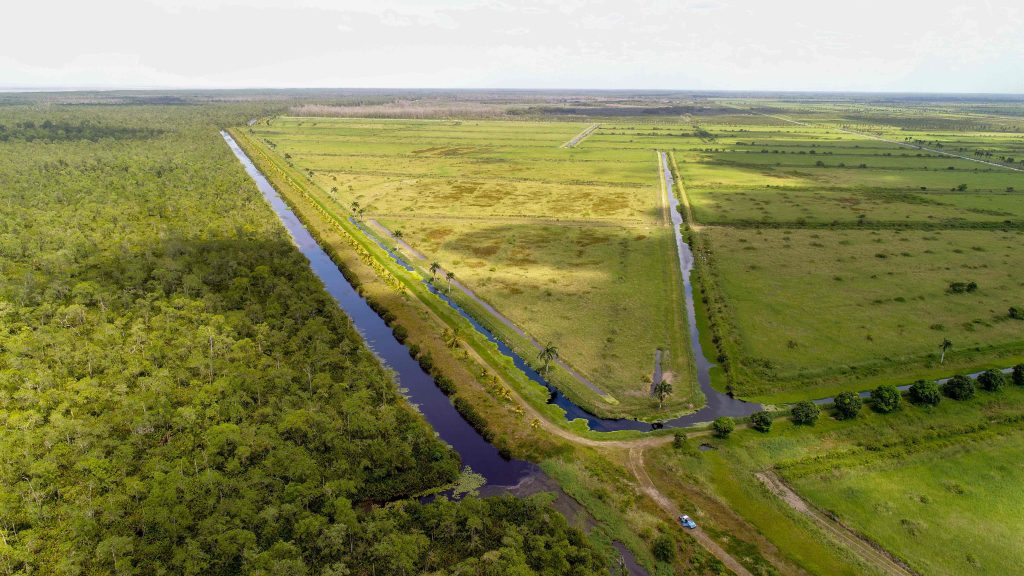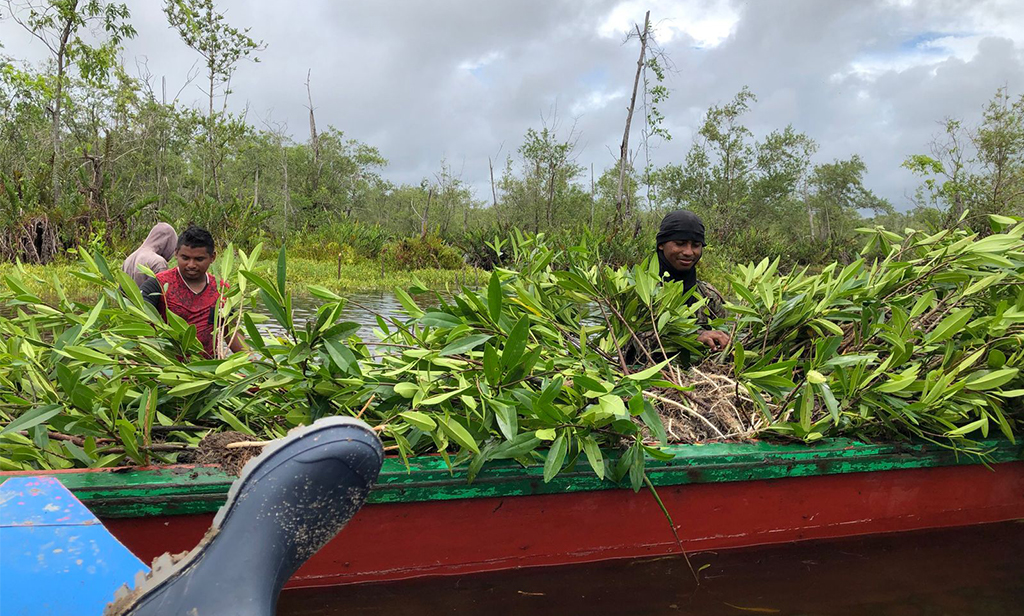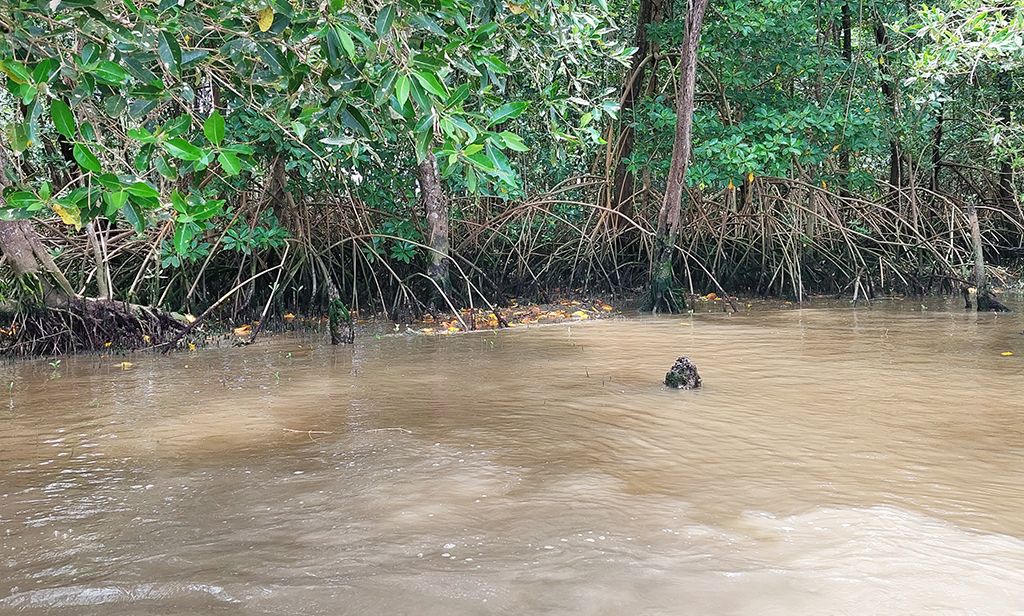Redeveloping and sustainably cultivating the plantations
Sustainability is focused on utilizing the available raw material on earth as long as possible and improving the living environment of all creatures.
Ever since the takeover of VCM Plantations by the Van Alen Family, the then Director, Armand van Alen (Director from 1979 to 2022), has approached in a sustainable manner the redevelopment of that which once was established as a plantation of food crops (including, cacao, sugarcane and rice) into main grasslands for the breeding of cattle, sheep, and goats (100% grass-fed livestock). His youngest son continues this approach, the current General Director John van Alen (2022 – present).
First, he reconstructed the ring dikes, sluices, and canals to prevent leaks and saltwater infiltration in the event of river surges in the surrounding areas and high water levels in the swamps on the right bank of the Commewijne and Suriname Rivers. Up to now, mainly the freshwater canals within the plantations are used for transporting the workers.
Below is a short overview of the crops which have preceded the present livestock farming:
Coffee, 1754 – 1888, and also cotton from 1861 to 1865.
Sugar, 1889 – 1934.
Plantain, cassava and rice, 1934 – 1947.
Cacao, 1947 – 1968.
Grassland (mainly) for livestock farming. Since 1979.
For the recultivation of the various neglected plantations, we used the following process:
- Around the area to be developed, we constructed a ring dike with a cable crane attached to a pontoon for the larger acreages. For the smaller ones, we used a hydraulic excavator.
- Block-shaped dams of approximately 10 – 20 hectares have been constructed, including the inside ditches.
- The blocks slowly become flooded as a result of the rainfall. When the growing point of vegetation is underwater, it dies off. The only vegetation that can withstand water can survive.
- We placed an overflow pipe so the water remains at a certain level and cannot spill over the ring dam, which could otherwise cause a dam burst. Depending on the rainfall, this process will take approximately six months.
- Once the vegetation has died off, we bring the water level back to a certain height. We plant German grass between the dead trees by hand, and the workers cut down any remaining vegetation. The German grass (Echinochloa polystachya) is propagated vegetatively in rows 70 cm apart because the seed is incapable of germinating.
- When the dams have dried up enough, they are finished with a bulldozer and then fenced in, with poles from walaba (a local hardwood from the interior) and five barbed wire rows.
- When the German grass has become mature and thick, the cattle are shooed in the field and spread and propagate the grass by walking and grazing in the area.
- African stargrass (Cynodon nlemfuensis) is planted on the ring dams, which grows flat on the soil surface and is more drought-resistant.
Grazing Land and Water Management
Efficient grazing land and water management are essential for keeping cattle on grassland.
Located in the young coastal plain, the VCM Plantations have heavy marine clay soil. To find the best vegetation, the owner has experimented with various types of grass in the past. Ultimately, it appeared that the so-called German grass (Echinochloa polystachya) and the African stargrass (Cynodon nlemfuensis) thrive best in this environment on the plantations and the dams.
The movement of cattle between grasslands is a crucial factor in the system.
A transhumance system is applied, whereby the challenge is to return to the same block in 30 days. This results in a lower infection pressure of parasites (worms). We do not use deworming medication for the cattle; they remain outside year in and year out and are not given supplementary feed. By sorting, we see to it that the pressure on the grass does not get too high.
With our transhumance system and focus on healthy cattle fodder, we guarantee that the meat sold at VCM Slagerijen is of animals bred in a natural habitat, ensuring you, our client, the most nutritious and tastiest meat. Taste the purity of our meat products and experience the difference!
As a company, we attach great importance to water management and ensure our plantations are adequately protected against floods. With our seven drainage sluices and a network of primary, secondary, and tertiary canals of 695 km in total, we are well prepared to drain excess water off our plantations.
The major canals extend over approximately 155 km of primary canals, 395 km of secondary canals, and 145 km of tertiary canals. The secondary canals serve as our drainage canals in the block, and our tertiary canals serve as our water buffers for the dry period so that the cattle dispose of drinking water at all times. We see to it that the primary canals are properly excavated and cleared before the start of the long rainy season to drain the water optimally.
As a company, we also consider climate changes and extreme weather conditions. The average annual rainfall is 2230 mm, but we have recently noticed an increase in the amount and intensity of the precipitation. In 2021 and 2022, we had almost 3 m of rain, and the rainfall intensity changed considerably. As a company, we will continue our efforts for the constant improvement of our water management and to ensure that our plantations and cattle at all times will have access to sufficient and clean drinking water.
The highest rainfall measured in 24 hours was 200 mm, the heaviest rain in 8 days was 425 mm, and the maximum we recorded per month was 612 mm.
In the dry season, we dispose of the water reserves of 3 separate wadoeks (reservoirs comprising 820 hectares). The surrounding dams have been erected sufficiently high to collect the rainfall during the rainy season for maximum utilization in the dry months.
The Water Management Project
In this respect, it is vital to cooperate with nature on water management. Dikes, canals, and sluices play a significant role in this respect, particularly in relation to the river tides. At low (ebb) tide, we discharge the excess water via a sluice into the river. This is an age-old process that is applied, especially during rainy seasons. Keeping the sluice gates tightly closed in the dry season is crucial.
At present, five old sluices are still in use today. These sluices are made from Dutch bricks. (The sluice gates have been replaced, of course.) The bricks were used as ballast on the journey from the Netherlands to the then colony of Suriname in ships transporting cargo from the colony to the mother country.
Armand van Alen and his team have designed several sluices throughout the years.
For example, at N.V. COMFISH there is a flap sluice that he designed. At high tide, the flap gate closes through the pressure of the water from outside. In contrast, the outflowing water from the Commewijne River
opens the entrance at low tide.
A sluice well worth the visit is the so-called ‘earring sluice’ (Dutch: oorbelsluis) on the Plantation Andrea’s Gift, built under Armand van Alen’s supervision, from 24 June through 28 October 2004.
At the outset, a pit was dug with the aid of a cable crane, whereby sheet piles were driven into the ground. The sheet piles, in turn, were delivered by the boom of a long-reach excavator, after which the hole was deepened further. On either side of the dam, there is additional shoring with parwa wood and cables and a so-called deadweight on the other side so the dam does not collapse further.
After the pit had been dug out to measure, a slatted frame was laid on which a 10 cm thick concrete work floor was poured to achieve a level structure. Especially for this purpose, a mix of raw materials was made in big bags (approximately 1 tonne), which were placed alongside the dam. This made it possible to place this mixture of water and cement in the concrete mixer truck using the cable crane. The concrete pump with a long boom stood on a pontoon in front of the excavated pit. It pumped concrete into wheelbarrows to be wheeled by workers to the farthest corners, which the pump could not reach. After the initial construction, the most exacting part of construction started. The central part of the sheet piles, intended for the water outlet, was destroyed to weave the ironwork into the foundation.
Following that, the ironwork of the walls was woven, and the wooden walls were erected so that the major concrete pour could be carried out in one go. In total, 225 m3 of concrete was poured for this sluice. The width of the water passage is 3.5 m. The ideal water level of the inland water measured from the bottom of the sluice is 2.25 meters. Thus a surface of 7.9 m2 has been reached. The highest level measured in the canals was 20 cm higher than the ideal level, up to 8.5 m2. The challenge is to deliver sufficient water to discharge it as quickly as possible because the water level in the hinterland drops fast when the sluice is open.
The sluice gate weighs approximately 4 tonnes, and Mr. Van Alen has attached two weights of around 600kg to the gate as counterweights, which brings about a leverage effect at ebb tide. As a result, a 5-tonne hoist suffices instead of a 10-tonne hoist, for instance, bringing about significant cost savings. What makes this sluice so unique is the movable flap gate which makes it possible for it to remain open and for the law of communicating vessels to come in. If the water level at the flap gate drops, the inland water pushes the door forward. If the pressure is high enough, the door on the front is lifted, resulting in the lowest resistance. This is the most efficient way of sluicing.
Another advantage of the rolling flap gate is that there is less swirling on the sides of the door, and the dams erode more slowly. In many other sluices, the flap gate has been adjusted as well; it has been fixed and does not roll out. And when the tide is turning, and anything gets stuck between the flap gate and the concrete wall, this yields a minor corner through which a lesser amount of river water can enter.
Meanwhile, N.V. Vabi has been active and has forged ahead with developing sluices that are relatively easy to install and now are available as prefab. Here we call these sluices the Vabi prefab sluices. In April 2020, the first Vabi prefab sluice was installed. These sluices help to manage the water level within the plantation better. In the meantime, eight of these small sluices have already been installed on the VCM Plantations, and there is a need for at least another five such sluices.


Crop, fish, and livestock farming
Given the increasing challenges in climate change and financial instability, adapting and optimizing our operations is of utmost importance. In these dynamic circumstances, we have to focus on obtaining maximum yield from the soil while at the same time maintaining sustainability and efficiency.
For the future, there is still 120 hectare available for cultivation into grassland. It is virtually impossible to reproduce German grass from seed. Thus, it is propagated vegetatively through planting, which is expensive and time-consuming. Two thick (mature) stem cuttings are stuck into the ground, 70 cm apart. The grass will sprout until it can be grazed by cattle and trampled for further propagation. In the first instance, only one cow can be placed per hectare. After approximately eight years, when the soil has matured, the number of cows can be increased gradually. Although there is a grass monoculture, we have planted various fruit trees on the dams. Certain parts are left alone, which promotes bird nesting, e.g., the Yellow-headed Blackbird (Xanthocephalus xanthocephalus). This bird serves as an indication of the presence of caterpillars that also eat the grass. A tiny butterfly lays countless eggs in the grass, and when these hatches, the caterpillars want to devour the grass. When the birds, wasps, and other animals cannot deal with it alone, we aid nature by spraying Biopel, a biological pesticide. This substance contains a bacterium that only attacks the caterpillar and does not affect the birds.
Also, we planted various tree species in the blocks of grassland. Among these, the neem tree is one of the most important. We planted Approximately 2,000 neem trees, emitting an insect-repellent odor that reduces the damage caused to the grass by caterpillars. The sheep and goats also regularly are fed pieces of neem leaves, thus keeping the intestinal parasites (worm populations) naturally in control. The diversity of trees planted creates abundant biodiversity in the area.
In addition, we planted 3,000 coconut trees on the dams. Plans are to increase this number in the future further. Coconut trees are suitable for this coastal area and can withstand the strong sea wind (northeast trade wind). And since these trees grow along the canals, they get sufficient water and nutrients. It is the plan to plant more coconut trees and improve the quality of the grown material.
For the sustainability of the whole, coconut fibers will have to be processed into coconut-based potting compost and coco peat. At the moment, VCM sells most of its coconut and coconut shells. A small part of the coconut crop is processed at the farm into packaged frozen grated coconut and serundeng. In ‘t VCM Hoekhuis cooled fresh coconut is always available.
In addition, VCM Plantations has a vegetable garden where various vegetables are cultivated for the VCM Butcher Shops in Paramaribo. The waste from the vegetable garden is used smartly: for the animals, the freshwater fishes, and some of the barn animals, or it is composted.
The waste of sheep and goat barns (manure and chopped grass) is also removed and brought to the compost site. The manure from the cattle stables is used in the vegetable garden. In this garden, a great variety of vegetables is grown, such as cassava, plantains, galangal, pumpkins, hot peppers, celery, groundnuts, water spinach, callaloo, spinach, papaya, guavas, gooseberry, June plum, and several tea varieties, such as lemongrass, marva, moringa, and graviola.
Along the canals/dams grow mango trees and noni bushes. These two crops also yield fruits for the Gourami fish. Gouramis are kept in very low densities and are fed finely chopped food from the plantation and vegetable garden (not marketable quality), as well as algae. Moreover, the water from the fish ponds is rich in nutrients. It can be used for the irrigation of the vegetable garden. In periods of extreme drought, there may be a freshwater shortage. We can then raise the water level in the fish ponds with rainwater saved in a reservoir of 10 hectares.




The Importance of Mangrove and Parwa Trees for the VCM Plantations
With the rise of the sea level and the threat of erosion along the coast, it is crucially important to protect the ecological zone around the VCM Plantations and the coastal region. The Mangrove and Parwa Project has been started to aid nature and protect the plantations from the effects of the Atlantic Ocean.
The VCM Plantations are situated in the Commewijne and Suriname Rivers’ estuary area near the Atlantic Ocean. Here, many mangrove and parwa trees provide extra protection to the ring dikes against the effects of the Atlantic Ocean. The area of the VCM Plantations is located between the ring dikes, the rivers, and the swampy area; in front of this area, to the north, the ecological zone is washed by the Ocean—this ecological zone functions as nursery grounds for many sea and river fish species and crustaceans.
In 2021, VCM started to support nature by planting more mangrove trees in the ecological zone. The trees, which have stilt roots, are better adapted to the sea level rise in the area. Parwa (black mangrove) trees, which have aerial roots, get suffocated and collapse.
In 2021, VCM planted 10,000 red mangrove seedlings in the ecological zone behind the plantations toward the Atlantic. Still, only a small number of these seedlings (approx. 480) survived the heavy rainfall shortly after.
In 2022, VCM decided to plant mangrove seeds on sites at suitable locations within the swampy area. Thus, 59,500 seeds were planted within a stretch of 10,5 km, and in 2023, 2,500 had already germinated. In so doing, we aim to accelerate the natural growth of the red mangrove, with its better resistance to the ocean swell waves. The planting of mangrove seeds proved very successful. Mangroves are important tree species for the coastal region. The mangrove is regarded as the exoskeleton of the area in which the VCM Plantations are located. It is also good to know that mangrove forests are the most efficient forest system for storing carbon dioxide, and they also have an essential role as nursery grounds for many sea and river fish species and crustaceans.
With this project, VCM contributes to not only the protection of its plantations but also the conservation of the coastal plain of Suriname and its biodiversity. The planting of mangrove seeds not only encourages natural growth but also improves carbon storage. Thus, VCM contributes positively to the fight against climate change. In short, VCM ‘s Mangrove and Parwa Project shows how businesses and nature can go well together. As the Surinamese saying goes: “Yu musu tan nanga wan futu na gron”. In other words, “We must live in harmony with nature” is precisely what VCM does.

